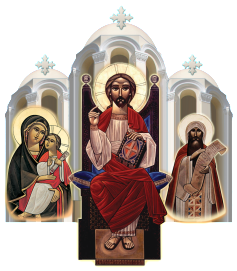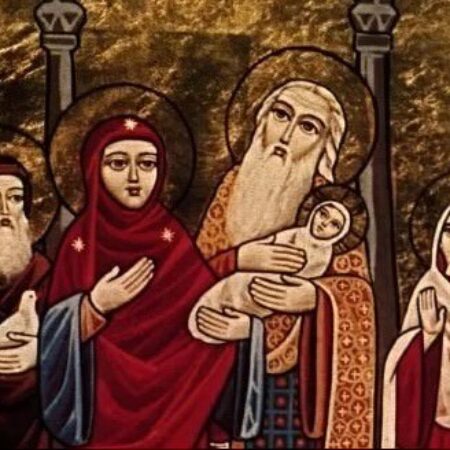In Jewish tradition, a mother of a newborn must go to the temple and offer an animal for a burnt offering and a sin offering 40 days after a boy is born or 80 days after having a girl (Leviticus 12). We commemorate the birth of Christ on the 29th of Kiahk, January 7. 40 days later is February 15th, or the 8th of Meshir. Hence, that is the day we commemorate the entry of our Lord into the Temple (Luke 2:25-39).
Upon entering into the Temple, St. Mary encounters a man named Simeon (Luke 2:25). Upon seeing the Child Jesus, St. Simeon exclaims: “‘Lord, now you are letting your servant depart in peace, according to your word; for my eyes have seen your salvation that you have prepared in the presence of all peoples, a light for revelation to the Gentiles, and for glory to your people Israel’” (Luke 2:29-31). Additionally, Simeon prophesied that “‘Behold, this child is appointed for the fall and rising of many in Israel, and for a sign that is opposed (and a sword will pierce through your own soul also), so that thoughts from many hearts may be revealed.’” (Luke 2:34-35). The opposed sign is referencing the Cross while the sword is referencing the grief that St. Mary will experience during His Crucifixion.
Encountering Christ was a significant moment for Simeon. As he is one of the seventy people who translated the Hebrew to Greek, a man who contributed to the Septuagint, he was concerned that the translation of Isaiah 7:14 read as “Behold, the virgin shall conceive and bear a son, and shall call his name Immanuel” instead of “young lady.” The Lord told him that he would not see death until he saw with his own eyes the fulfillment of this prophecy. St. Simeon had been waiting for this moment for hundreds of years.
Also found at the temple was St. Anna the Prophetess. She was telling Israelites who were waiting for the redemption of Jerusalem about Christ (Luke 2:38).
The liturgical rites for the feast day reflect the proclamations of St. Simeon and St. Anna. After reading this passage from St. Luke, the physical Gospel (the Beshara) is wrapped in white, held like a baby, and processed around the altar three times. During the procession, deacons are also holding candles (why this Feast is also known as Candlemas). While processing, we sing the seventh part of the Wednesday Theotokia, which starts with “The Galilee of the Gentiles, who sit in darkness, and in the shadow of death, had the great Light shine to them.” This verse serves as a reminder of how Christ is the Light of the World.
Though considered as “minor”, this Feast is significant. Even after Christ was born, there were many prophets that continually proclaimed that Christ would redeem both Jerusalem, as evident by St. Anna, and the Gentiles, as proclaimed by St. Simeon. As St. Simeon passes away, we are reminded of how God will fulfill His Word. Most importantly, we are reminded of how Christ is truly the Light of the World.
Sources:
- Luke 2
- Isaiah 7
- Catena for St. Ambrose’s commentaries on Luke 2
- https://www.stvnashville.org/presentation-of-the-lord-christ-in-the-temple
- 09 – Feast of the Entry into the Temple – HCOC
- Weekdays Theotokeias :: Ti–galili–a (7th Part of the Wednesday Theotokia) :: لحن تي جاليلي آه – القطعة السابعة من ثيؤطوكية الأربعاء :: Ϯⲅⲁⲗⲓⲗⲉⲁ̀ (Ϯⲙⲁϩϣⲁϣϥⲓ)
- Synaxarium (as seen on Coptic Reader)

